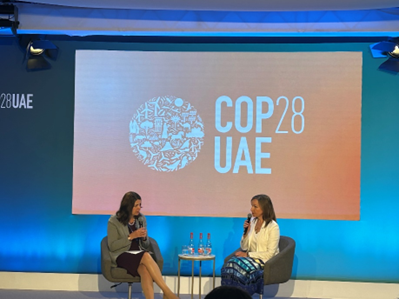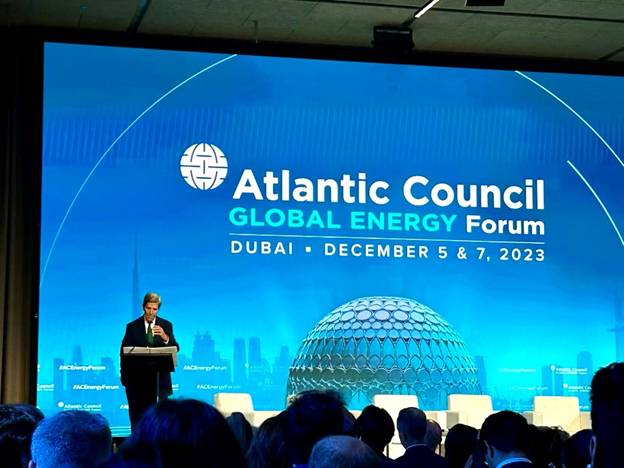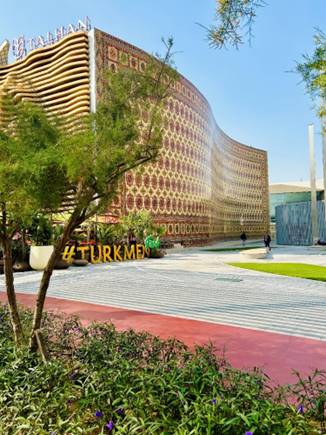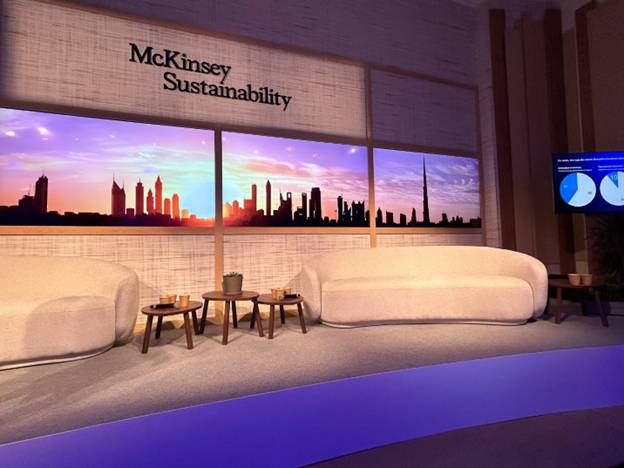Fixing Climate Finance
It was Finance Day at #COP28, and there was talk of money everywhere.
You might expect that in Dubai, with its splashy display of wealth and ambition at every turn. But at the big UN climate conference that’s underway here, there were plenty of questions about where that money is coming from and where it needs to go.
Bottom line: we need to mobilize $100 trillion over the next 25 years, and even by Dubai that standards requires a stretch of imagination.
Let’s start with the big bucks. The host of this year’s climate mela, the United Arab Emirates, is among many nations looking to invest in this new age of emissions-free development. The Dubai COP (for Conference of the Parties that have signed the UN climate framework) has already raised $57 billion from member states, according to the organizers. In addition, the UAE has pledged $270 billion by 2030. The oil-rich host is also developing a proposal for a $50 billion climate investment fund, which it along with BlackRock and TPG would finance.
Much of that money is needed in lower-income countries, where industry is not able to finance a transition to non-polluting energy systems, and large investors are showing what can be done through things like solar farm and hydrogen production.
The smaller bucks are more challenging. That’s the stuff of carbon markets that allow polluters to pay people and companies around the world for climate-smart actions like tree-planting or no-till farming to absorb some of the greenhouse gases they emit. Such markets are growing slowly but steadily, promising to eventually transfer billions of dollars and inspire waves of better emissions management.
But over the past year, a spate of scandals — misreporting of tree-planting, for instance — has slowed their development.
I sat with some of the world’s largest investors on Finance Day, listening to their concerns about these growing pains for carbon markets. They’re worried climate “purists” will prevent this relatively new market from maturing. They need only look out the door to an official COP poster that reads, “let’s fix climate finance.”
The debate continues whether that can happen fast enough, especially when the finance world is still talking billions when trillions may be needed.

Also on Finance Day, Canada was on the global stage talking Indigenous equity. Chana Martineau (right, below), the CEO of Alberta Indigenous Opportunities Corporation, took the stage with Alberta Premier Danielle Smith (left) to explain how the province’s $3 billion loan guarantee facility has helped Indigenous communities gain a share and say in economic development. In just four years, the AIOC has helped produce thousands of jobs, $27 million a year in new income for communities and a clear path for $1.5 billion in benefits over the next 30 years.
Think what Canada could do with a national Indigenous loan guarantee, like the one promoted in the Fall Economic Statement. A great moment for reconcili-action.
Beyond Fossil Fuels

It’s Energy Day at #COP28 in Dubai, and given the location for the big UN Climate Conference, you might think it means oil and gas. Think again.
Fossil fuels are, of course, a focus of COP, but there’s also emphasis on renewables and nuclear. This region is fast becoming a centre for solar and wind power. It’s also one of the many growth regions for nuclear, which it wants to help champion. COP28 has already won agreement by 50 countries to triple nuclear production by 2050; one of them, China, is building 22 nuclear plants (although it has 5,000 coal-fired electricity plans). And in Europe, Germany is close to 50% renewable.
For many here, the focus of Energy Day was fixed was less on energy supply and more on energy security — at the national and household level. Countries on every continent continue to exhibit scar tissue from Russia’s Ukraine invasion, which caused prices to spike. They seem to generally too adhere to the new American doctrine that energy security is national security.
African leaders, in particular, spent the day voicing concerns about their own vulnerability to energy shortages and shocks. Many of those countries are still reliant on biomass to heat and cook, and could use better access to natural gas before they transition fully to renewables.
Into the gap come newer energy technologies like hydrogen and fusion, as well as abatement technologies like carbon capture and nuclear fusion. John Kerry, the US special envoy on climate, said he’s finally convinced fusion is no longer “30 years away.” And if that’s the case, it has the potential to transform the way the world powers itself.
Europe continues to push hydrogen, but the economics may not work.
Kerry was frank in his assessment that energy demand will continue to rise with economic and population growth: “Demand needs to be addressed.”
He urged the UN conference to set two priorities. One is to ensure all production is abated; that is, producers capture emissions that leave a plant, refinery or well. Second is to focus on methane reduction, where the sector is making enormous gains. More than 50 companies at this COP have signed the Global Methane Pledge.
With one week to go at COP28, the Dubai leadership at COP wants to maintain that focus, believing the sector can engineer itself to a cleaner future. In the coming days, it will try to make the case that in the long run, climate security will require energy security.
Glass & Steel Shrouded By Climate Anxiety

It was Buildings Day at COP28, and where better to discuss the climate impact of office towers and urban sprawl than Dubai.
Like many cities in emerging markets, Dubai’s shimmering skyline used to epitomize the human quest for progress and prosperity. Now, all that glass and steel is shrouded by climate anxiety.
Construction contributes to 40% of global emissions, sending 38 billion of tonnes of carbon dioxide into the atmosphere every year, largely from the intense heat required to make steel and concrete. At recent growth rates, emissions could double in the next 25 years, as hundreds of millions of people move to cities. And the climate oil pact would be severe. Think of all the heat needed to make all the steel and glass.

I was part of one COP28 panel that included cement companies and engineers explaining what’s possible and not. We agreed the building sector needs to find new ways to bundle climate friendly buildings, for investors and tenants, and disaggregate elements of them for investors who may want to own part of a building, like a solar-paneled rooftop, and others to stick to the main course.
Governments can do more with procurement, too, instructing developers to ensure new schools, hospitals and public office spaces are as close to Net Zero ready as possible.
The consulting firm McKisney & Co. estimates 11% of all building’s emissions could be cut with better management practices, and that don’t add to the construction costs of a building. Those savings could grow to 22% by 2030, and 40% if some costs were absorbed.
A city like Dubai could probably pay for that, using current oil and gas revenues. But it may need support to invest more.
Further down the road, new approaches like offsite construction, electrified site equipment and recycled scrap steel could help. And there are new technologies like heat pumps that can dramatically change local energy systems.
Dubai — and fast-growing cities like it — could be a good test case. The conference centre where the United Nations is gathering is more like a campus of low-rise and open buildings, each repurposed this week for climate. Such unobtrusive buildings could be a template for a new kind or urbanism — if rapidly developing countries are willing to forego skyscrapers.
Diane Hoskins, a leading architect who is co-CEO of Gensler, told our COP gathering that architects and engineers need to be more flexible, as do local governments. And they need to ensure buildings not only fight climate change, but are resilient to its harsh impacts, including heat.
The best efforts may emanate from successful business models, as the profit motive becomes an ever-more powerful driver of climate action.
A good example can be found in Hong Kong, where MPD Energy has helped the construction industry get off fossil fuels by deploying portable batteries to power equipment. Just three years ago, 100% of construction in Hong Kong relied on fossil fuels. Today, it’s 40%, thanks to batteries that can produce up to 500 kW of power and have already helped the industry cut its emissions by 40%.
The Abate Debate

Get used to the word “unabated.” It’s a clunky term that’s fast-taking centre stage at the United Nations climate conference in Dubai. The world’s major economic powers and oil producers, including host country United Arab Emirates, want COP28 to call for the winding down of “unabated” fossil fuel production, meaning anything that doesn’t capture greenhouse gas emissions at source.
Opponents of the term fear it will give oil and gas producers carte blanche to produce as much as they want, as long as they’re using carbon capture technologies. They fear such an enthusiasm for abatement overlooks the emissions caused by the combustion of fossil fuels when people drive their cars or heat their homes. And they worry there’s not enough proof that abatement technologies work at the scale that will be needed.
The abate debate will likely define COP28, which is living up to its nickname as the “Oil and Gas COP.” Not surprisingly, given its location, the conference has attracted large delegations from oil producing countries, as well as executive teams from many of the world’s biggest oil and gas companies.
They’re promoting a view that the world relies heavily on fossil fuels and won’t reduce that dependency any time soon, no matter how fast the growth of renewable energy. One astonishing fact that a UAE oil executive shared today: at the time of the world’s first climate summit, in 1992, roughly 82% of the world’s energy came from oil, gas and coal; today, during COP28, that share is 80%. Surprisingly, more than a quarter of the world’s energy still comes from coal.
Such slow progress has many climate activists pushing for more radical solutions, to force wholesale change to renewable energy. But they’re swimming against some strong currents of both supply and demand. The United States, which is now the world’s largest oil producer, is on course to pump a record amount this year and may look to increase that again next year — an election year, no less – to keep gas prices low. That’s fueling speculation that Saudi Arabia will ramp up its own production, to drive prices even lower and drive US producers out of business.
The potential of another oil war drew an unlikely visitor, Vladimir Putin, to the UAE this week. The Russian leader didn’t attend COP but he did meet with Emirati leaders, before heading to Saudi Arabia, to talk about oil production. The UAE is the world’s eighth largest oil producer and is looking to increase supply by 40% this decade.
Can all that production be abated? It’s a question COP28 likely can’t answer. But it will try to challenge the world with it.
This article is intended as general information only and is not to be relied upon as constituting legal, financial or other professional advice. A professional advisor should be consulted regarding your specific situation. Information presented is believed to be factual and up-to-date but we do not guarantee its accuracy and it should not be regarded as a complete analysis of the subjects discussed. All expressions of opinion reflect the judgment of the authors as of the date of publication and are subject to change. No endorsement of any third parties or their advice, opinions, information, products or services is expressly given or implied by Royal Bank of Canada or any of its affiliates.


 Learn More
Learn More